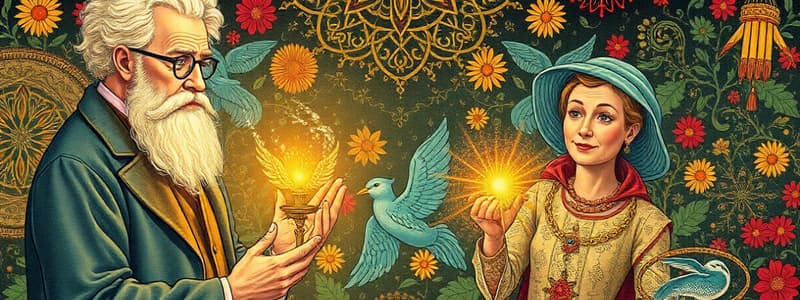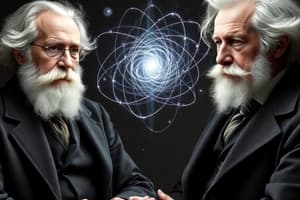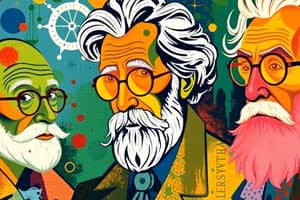Podcast
Questions and Answers
Which theory did Fred Hoyle propose that maintained a constant average density in an expanding universe?
Which theory did Fred Hoyle propose that maintained a constant average density in an expanding universe?
- Nebular Hypothesis
- Relativity Theory
- Steady State Theory (correct)
- Big Bang Theory
What condition is associated with having an extra chromosome, leading to 47 chromosomes instead of the usual 46?
What condition is associated with having an extra chromosome, leading to 47 chromosomes instead of the usual 46?
- Huntington's disease
- Sickle cell disease
- Down syndrome (correct)
- Cystic fibrosis
What crucial calculations was Katherine Johnson known for during her time at NASA?
What crucial calculations was Katherine Johnson known for during her time at NASA?
- Astrophysics simulations
- Earthquake prediction algorithms
- Trajectory calculations for space missions (correct)
- Weather prediction models
Which propulsion system was invented by Yvonne Brill to keep unmanned spacecraft in stationary orbit?
Which propulsion system was invented by Yvonne Brill to keep unmanned spacecraft in stationary orbit?
Which of the following areas did Abdus Salam specialize in during his studies?
Which of the following areas did Abdus Salam specialize in during his studies?
What did Fred Hoyle famously coin during a radio talk regarding the competing theory to his own?
What did Fred Hoyle famously coin during a radio talk regarding the competing theory to his own?
In which year did Katherine Johnson help plan the Apollo 11 Moon mission?
In which year did Katherine Johnson help plan the Apollo 11 Moon mission?
Which type of research did Irene Uchida focus on during her career?
Which type of research did Irene Uchida focus on during her career?
Which theory explains the weak interaction between subatomic particles and unifies it with the electromagnetic force?
Which theory explains the weak interaction between subatomic particles and unifies it with the electromagnetic force?
What was Vera Rubin's significant discovery about stars in spiral galaxies?
What was Vera Rubin's significant discovery about stars in spiral galaxies?
What phenomenon did Peter Higgs propose to explain the origin of mass in elementary particles?
What phenomenon did Peter Higgs propose to explain the origin of mass in elementary particles?
For what discovery was Eric Kandel awarded the Nobel Prize?
For what discovery was Eric Kandel awarded the Nobel Prize?
What did Mario Molina demonstrate about chlorofluorocarbon compounds (CFCs)?
What did Mario Molina demonstrate about chlorofluorocarbon compounds (CFCs)?
What did Lap-Chee Tsui help discover related to cystic fibrosis?
What did Lap-Chee Tsui help discover related to cystic fibrosis?
In which year did Mae Carol Jemison become the first African American woman in space?
In which year did Mae Carol Jemison become the first African American woman in space?
What is Donna Strickland known for developing?
What is Donna Strickland known for developing?
What role do telomeres play in cell biology, as studied by Carol Greider?
What role do telomeres play in cell biology, as studied by Carol Greider?
Which organization awarded the Nobel Prize in Physics to Peter Higgs?
Which organization awarded the Nobel Prize in Physics to Peter Higgs?
What was the primary focus of Eric Kandel's research using sea slugs?
What was the primary focus of Eric Kandel's research using sea slugs?
What was one of the main outcomes of Rubin's research on galaxy rotation?
What was one of the main outcomes of Rubin's research on galaxy rotation?
What technical advancement is associated with Donna Strickland's work?
What technical advancement is associated with Donna Strickland's work?
What key idea did Peter Higgs contribute to particle physics?
What key idea did Peter Higgs contribute to particle physics?
Flashcards
Fred Hoyle
Fred Hoyle
A British astrophysicist who proposed the theory that most chemical elements are created through nuclear reactions within stars. He also advocated for the steady state theory, which suggests that the Universe's density remains constant as it expands.
Steady State Theory
Steady State Theory
A theory that posits that the Universe maintains a constant density as it expands by continuously creating new matter.
Irene Uchida
Irene Uchida
A Canadian medical geneticist who researched the impact of genes and chromosomes on health, focusing on genetic disorders and chromosomal abnormalities.
What did Irene Uchida investigate?
What did Irene Uchida investigate?
Signup and view all the flashcards
Katherine Johnson
Katherine Johnson
Signup and view all the flashcards
Yvonne Brill
Yvonne Brill
Signup and view all the flashcards
Abdus Salam
Abdus Salam
Signup and view all the flashcards
What did Abdus Salam specialize in?
What did Abdus Salam specialize in?
Signup and view all the flashcards
Electroweak theory
Electroweak theory
Signup and view all the flashcards
Messenger particles
Messenger particles
Signup and view all the flashcards
What did Vera Rubin discover about galaxy rotation?
What did Vera Rubin discover about galaxy rotation?
Signup and view all the flashcards
Dark matter
Dark matter
Signup and view all the flashcards
Higgs field
Higgs field
Signup and view all the flashcards
Higgs boson
Higgs boson
Signup and view all the flashcards
What is the Large Hadron Collider (LHC)?
What is the Large Hadron Collider (LHC)?
Signup and view all the flashcards
Synapses
Synapses
Signup and view all the flashcards
How did Eric Kandel study memory?
How did Eric Kandel study memory?
Signup and view all the flashcards
CFCs (chlorofluorocarbons)
CFCs (chlorofluorocarbons)
Signup and view all the flashcards
What did Mario Molina and Sherwood Rowland discover about CFCs?
What did Mario Molina and Sherwood Rowland discover about CFCs?
Signup and view all the flashcards
Cystic fibrosis
Cystic fibrosis
Signup and view all the flashcards
What did Lap-Chee Tsui discover about cystic fibrosis?
What did Lap-Chee Tsui discover about cystic fibrosis?
Signup and view all the flashcards
Chirped pulse amplification (CPA)
Chirped pulse amplification (CPA)
Signup and view all the flashcards
Telomeres
Telomeres
Signup and view all the flashcards
Study Notes
Scientists and Their Contributions
- Fred Hoyle (1915-2001): British astrophysicist, proposed the step-by-step creation of chemical elements in stars via nuclear reactions. Also a proponent of the steady state theory of the universe, which postulates a constant density despite expansion, as new matter is created continuously. He used the term "Big Bang" to describe the rival theory, but negatively.
- Irene Uchida (1917-2013): Canadian medical geneticist, researched how genes and chromosomes affect health, focusing on chromosome differences in genetic conditions like Down syndrome and congenital heart disease and effects of X-rays on chromosomes.
- Katherine Johnson (1918-): American mathematician, calculated trajectories for many space missions, including Alan Shepard's, and was key to the Apollo 11 Moon mission planning. Worked at NACA/NASA from 1953-1986.
- Yvonne Brill (1924-2013): Canadian inventor, developed a propulsion system for unmanned spacecraft to maintain stationary orbit, worked on thrusters for weather satellites, rocket designs, and the Mars Observer. Worked at NASA from 1981-1983.
- Abdus Salam (1926-1996): Pakistani physicist, developed the electroweak theory, explaining the weak interaction between subatomic particles and its unification with the electromagnetic force. His theory, predicting messenger particles for the weak force, was confirmed at CERN (1973) and he was awarded a Nobel Prize (1979).
- Vera Rubin (1928-2016): Discovered that stars in the outer parts of galaxies orbit as fast as those closer to the center, contradicting Newtonian gravity. Her research led to the understanding of dark matter.
- Peter Higgs (1929-): Developed a theory explaining the origin of elementary particle mass through interactions with a permeating Higgs field, predicting the existence of a Higgs boson particle. His work fueled the Large Hadron Collider project, which successfully detected the Higgs boson (2012). Received the Nobel Prize (2013).
- Eric Kandel (1929-): Studied the cellular basis of behavior and the role of synapses in memory and learning using the sea slug as a model organism. Awarded Nobel Prize (2000).
- Mario Molina (1943-): Mexican chemical engineer who, with Sherwood Rowland, showed that chlorofluorocarbons (CFCs) destroy the ozone layer. This work led to the banning/limitation of CFCs and won them a Nobel Prize (1995).
- Lap-Chee Tsui (1950-): Canadian medical geneticist, helped to identify the faulty gene responsible for cystic fibrosis.
- Mae Jemison (1956-): First African American woman in space, flew on the space shuttle Endeavour in 1992.
- Donna Strickland (1959-): Canadian optical physicist, developed chirped pulse amplification (CPA) with Gérard Mourou, leading to the shortest and most intense laser pulses. Awarded a Nobel Prize (2018).
- Carol Greider (1961-): American molecular biologist, researched telomeres and telomerase, and discovered that inhibiting telomerase in cancer cells can slow tumor growth. Awarded a Nobel Prize (2009).
Additional Information
- Extra chromosome: A condition where individuals have an extra chromosome (47 instead of 46) in their cells. Down syndrome is an example.
Studying That Suits You
Use AI to generate personalized quizzes and flashcards to suit your learning preferences.




